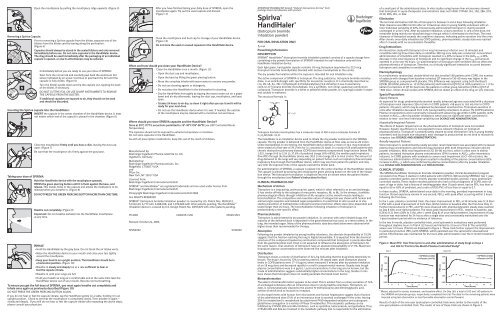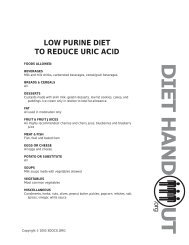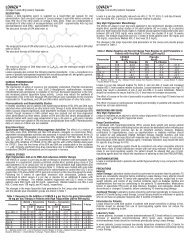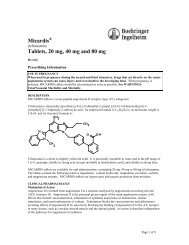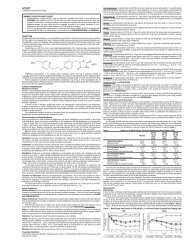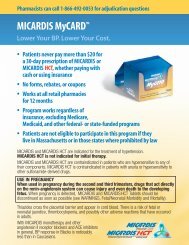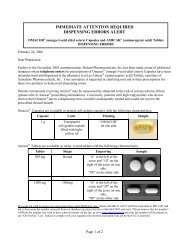Spiriva® HandiHaler® - Pharmacist eLink
Spiriva® HandiHaler® - Pharmacist eLink
Spiriva® HandiHaler® - Pharmacist eLink
Create successful ePaper yourself
Turn your PDF publications into a flip-book with our unique Google optimized e-Paper software.
Removing a Spiriva Capsule:Open the mouthpiece by pulling the mouthpiece ridge upwards. (Figure 3)Prior to removing a Spiriva capsule from the blister, separate one of theblisters from the blister card by tearing along the perforation.(Figure 4)Capsules should always be stored in the sealed blisters and only removedimmediately before use. Do not store capsules in the HandiHaler device.The drug should be used immediately after the packaging of an individualcapsule is opened, or else its effectiveness may be reduced.Immediately before you are ready to use your dose of SPIRIVA:Start from the corner tab and carefully peel back the aluminum foilwhere indicated by an arrow. Continue to peel back the foil until thecapsule is fully visible. (Figure 5)Turn the blister upside down and tip the capsule out, tapping the backof the blister, if necessary.DO NOT CUTTHE FOIL OR USE SHARP INSTRUMENTS TO REMOVETHE CAPSULE FROM THE BLISTER.If additional capsules are exposed to air, they should not be usedand should be discarded.Inserting the Spiriva capsule into the HandiHaler:INSERT the capsule in the center chamber of the HandiHaler device. It doesnot matter which end of the capsule is placed in the chamber. (Figure 6)Taking your dose of SPIRIVA:Close the mouthpiece firmly until you hear a click, leaving the dust capopen. (Figure 7)Be sure that the mouthpiece sits firmly against the gray base.Hold the HandiHaler device with the mouthpiece upwards.PRESS the green piercing button until it is flush against the base, andrelease. This makes holes in the capsule and allows the medication to bereleased when you breathe in. (Figure 8)DO NOT PRESS THE GREEN PIERCING BUTTON MORE THAN ONE TIME.Breathe out completely. (Figure 9)Important: Do not breathe (exhale) into the HandiHaler mouthpieceat any time.INHALE• Hold the HandiHaler by the gray base. Do not block the air intake vents.• Raise the HandiHaler device to your mouth and close your lips tightlyaround the mouthpiece.• Keep your head in an upright position. The HandiHaler should be ina horizontal position. (Figure 10)• Breathe in slowly and deeply but at a rate sufficient to hear orfeel the capsule vibrate.• Breathe in until your lungs are full.• Hold your breath as long as is comfortable and at the same time take theHandiHaler device out of your mouth. Resume normal breathing.To ensure you get the full dose of SPIRIVA, you must again breathe out completely andinhale once again as previously described (Figure 10).DO NOT PRESS THE GREEN PIERCING BUTTON AGAIN.If you do not hear or feel the capsule vibrate, tap the HandiHaler gently on a table, holding it in anupright position. Check to see that the mouthpiece is completely closed. Then breathe in again –slowly and deeply. If you still do not hear or feel the capsule vibrate after repeating the above steps,please consult your physician.After you have finished taking your daily dose of SPIRIVA, open themouthpiece again. Tip out the used capsule and discard.(Figure 11)Close the mouthpiece and dust cap for storage of your HandiHaler device.(Figure 12)Do not store the used or unused capsules in the HandiHaler device.When and how should you clean your HandiHaler Device?Clean the HandiHaler once a month. (Figure 13)• Open the dust cap and mouthpiece.• Open the base by lifting the green piercing button.• Rinse the complete inhaler with warm water to remove any powder.• Do not use cleaning agents or detergents.• Do not place the HandiHaler in the dishwasher for cleaning.• Dry the HandiHaler thoroughly by tipping the excess water out on a papertowel and air-dry afterwards, leaving the dust cap, mouthpiece, and baseopen.• It takes 24 hours to air dry, so clean it right after you use it and it will beready for your next dose.• Do not use the HandiHaler device when it is wet. If needed, the outsideof the mouthpiece may be cleaned with a moist but not wet tissue.Where should you store SPIRIVA capsules and the HandiHaler Device?Store at 25°C (77°F); excursions permitted to 15°–30°C (59°–86°F) [see USP Controlled RoomTemperature].The capsules should not be exposed to extreme temperature or moisture.Do not store capsules in the HandiHaler.As with all prescription medications, keep this out of the reach of children.Manufactured by:Boehringer Ingelheim Pharma GmbH & Co. KGIngelheim, GermanyMarketed by:Boehringer Ingelheim Pharmaceuticals, Inc.Ridgefield, CT 06877 USAandPfizer Inc.New York, NY 10017 USALicensed from:Boehringer Ingelheim International GmbHSPIRIVA® and <strong>HandiHaler®</strong> are registered trademarks and are used under license fromBoehringer Ingelheim International GmbH©Copyright Boehringer Ingelheim International GmbH 2006ALL RIGHTS RESERVEDSPIRIVA® (tiotropium bromide inhalation powder) is covered by U.S. Patent Nos. RE38,912,5,610,163, 6,777,423, 6,908,928, and 7,070,800 with other patents pending. The <strong>HandiHaler®</strong>inhalation device is covered by U.S. Design Patent No. D355,029 with other patents pending.IT1600I 10004551/US1 65626/US/1Revised: October 24, 2006SP282222SV39202ATTENTION PHARMACIST: Detach “Patient's Instructions for Use” frompackage insert and dispense with product.<strong>Spiriva®</strong><strong>HandiHaler®</strong>(tiotropium bromideinhalation powder)FOR ORAL INHALATION ONLYPrescribing InformationDESCRIPTIONSPIRIVA® <strong>HandiHaler®</strong> (tiotropium bromide inhalation powder) consists of a capsule dosage formcontaining a dry powder formulation of SPIRIVA intended for oral inhalation only with theHandiHaler inhalation device.Each light green, hard gelatin capsule contains 18 mcg tiotropium (equivalent to 22.5 mcgtiotropium bromide monohydrate) blended with lactose monohydrate as the carrier.The dry powder formulation within the capsule is intended for oral inhalation only.The active component of SPIRIVA is tiotropium. The drug substance, tiotropium bromide monohydrate,is an anticholinergic with specificity for muscarinic receptors. It is chemically described as(1α, 2ß, 4ß, 5α, 7ß)-7-[(Hydroxydi-2-thienylacetyl)oxy]-9,9-dimethyl-3-oxa-9-azoniatricyclo[3.3.1.02,4 ]nonane bromide monohydrate. It is a synthetic, non-chiral, quaternary ammoniumcompound. Tiotropium bromide is a white or yellowish white powder. It is sparingly soluble in waterand soluble in methanol.The structural formula is:Tiotropium bromide (monohydrate) has a molecular mass of 490.4 and a molecular formula ofC 19 H 22 NO 4 S 2 Br • H 2 O.The HandiHaler is an inhalation device used to inhale the dry powder contained in the SPIRIVAcapsule. The dry powder is delivered from the HandiHaler device at flow rates as low as 20 L/min.Under standardized in vitro testing, the HandiHaler device delivers a mean of 10.4 mcg tiotropiumwhen tested at a flow rate of 39 L/min for 3.1 seconds (2L total). In a study of 26 adult patients withchronic obstructive pulmonary disease (COPD) and severely compromised lung function [mean FEV 11.02 L (range 0.45 to 2.24 L); 37.6% of predicted (range 16%–65%)], the median peak inspiratoryflow (PIF) through the HandiHaler device was 30.0 L/min (range 20.4 to 45.6 L/min). The amount ofdrug delivered to the lungs will vary depending on patient factors such as inspiratory flow and peakinspiratory flow through the HandiHaler device, which may vary from patient to patient, and mayvary with the exposure time of the capsule outside the blister pack.For administration of SPIRIVA, a capsule is placed into the center chamber of the HandiHaler device.The capsule is pierced by pressing and releasing the green piercing button on the side of the inhalationdevice. The tiotropium formulation is dispersed into the air stream when the patient inhalesthrough the mouthpiece (see Patient’s Instructions for Use).CLINICAL PHARMACOLOGYMechanism of ActionTiotropium is a long-acting, antimuscarinic agent, which is often referred to as an anticholinergic.It has similar affinity to the subtypes of muscarinic receptors, M 1 to M 5 . In the airways, it exhibitspharmacological effects through inhibition of M 3 -receptors at the smooth muscle leading tobronchodilation. The competitive and reversible nature of antagonism was shown with human andanimal origin receptors and isolated organ preparations. In preclinical in vitro as well as in vivostudies prevention of methacholine-induced bronchoconstriction effects were dose-dependent andlasted longer than 24 hours. The bronchodilation following inhalation of tiotropium ispredominantly a site-specific effect.PharmacokineticsTiotropium is administered by dry powder inhalation. In common with other inhaled drugs, themajority of the delivered dose is deposited in the gastrointestinal tract and, to a lesser extent, in thelung, the intended organ. Many of the pharmacokinetic data described below were obtained withhigher doses than recommended for therapy.AbsorptionFollowing dry powder inhalation by young healthy volunteers, the absolute bioavailability of 19.5%suggests that the fraction reaching the lung is highly bioavailable. It is expected from the chemicalstructure of the compound (quaternary ammonium compound) that tiotropium is poorly absorbedfrom the gastrointestinal tract. Food is not expected to influence the absorption of tiotropium forthe same reason. Oral solutions of tiotropium have an absolute bioavailability of 2–3%. Maximumtiotropium plasma concentrations were observed five minutes after inhalation.DistributionTiotropium shows a volume of distribution of 32 L/kg indicating that the drug binds extensively totissues. The drug is bound by 72% to plasma proteins. At steady state, peak tiotropium plasmalevels in COPD patients were 17–19 pg/mL when measured 5 minutes after dry powder inhalationof an 18 mcg dose and decreased rapidly in a multi-compartmental manner. Steady state troughplasma concentrations were 3–4 pg/mL. Local concentrations in the lung are not known, but themode of administration suggests substantially higher concentrations in the lung. Studies in ratshave shown that tiotropium does not readily penetrate the blood-brain barrier.BiotransformationThe extent of biotransformation appears to be small. This is evident from a urinary excretion of 74%of unchanged substance after an intravenous dose to young healthy volunteers. Tiotropium, anester, is nonenzymatically cleaved to the alcohol N-methylscopine and dithienylglycolic acid,neither of which bind to muscarinic receptors.In vitro experiments with human liver microsomes and human hepatocytes suggest that a fractionof the administered dose (74% of an intravenous dose is excreted unchanged in the urine, leaving25% for metabolism) is metabolized by cytochrome P450-dependent oxidation and subsequentglutathione conjugation to a variety of Phase II metabolites. This enzymatic pathway can beinhibited by CYP450 2D6 and 3A4 inhibitors, such as quinidine, ketoconazole, and gestodene. Thus,CYP450 2D6 and 3A4 are involved in the metabolic pathway that is responsible for the eliminationof a small part of the administered dose. In vitro studies using human liver microsomes showedthat tiotropium in supra-therapeutic concentrations does not inhibit CYP450 1A1, 1A2, 2B6, 2C9,2C19, 2D6, 2E1, or 3A4.EliminationThe terminal elimination half-life of tiotropium is between 5 and 6 days following inhalation.Total clearance was 880 mL/min after an intravenous dose in young healthy volunteers with aninter-individual variability of 22%. Intravenously administered tiotropium is mainly excretedunchanged in urine (74%). After dry powder inhalation, urinary excretion is 14% of the dose, theremainder being mainly non-absorbed drug in the gut which is eliminated via the feces. The renalclearance of tiotropium exceeds the creatinine clearance, indicating active secretion into the urine.After chronic once-daily inhalation by COPD patients, pharmacokinetic steady state was reachedafter 2–3 weeks with no accumulation thereafter.Drug InteractionsAn interaction study with tiotropium (14.4 mcg intravenous infusion over 15 minutes) andcimetidine 400 mg three times daily or ranitidine 300 mg once daily was conducted. Concomitantadministration of cimetidine with tiotropium resulted in a 20% increase in the AUC 0–4h , a 28%decrease in the renal clearance of tiotropium and no significant change in the C max and amountexcreted in urine over 96 hours. Co-administration of tiotropium with ranitidine did not affect thepharmacokinetics of tiotropium. Therefore, no clinically significant interaction occurred betweentiotropium and cimetidine or ranitidine.ElectrophysiologyIn a multicenter, randomized, double-blind trial that enrolled 198 patients with COPD, the numberof subjects with changes from baseline-corrected QT interval of 30–60 msec was higher in theSPIRIVA group as compared with placebo. This difference was apparent using both the Bazett(QTcB) [20 (20%) patients vs. 12 (12%) patients] and Fredericia (QTcF) [16 (16%) patients vs. 1 (1%)patient] corrections of QT for heart rate. No patients in either group had either QTcB or QTcF of>500 msec. Other clinical studies with SPIRIVA did not detect an effect of the drug on QTc intervals.Special PopulationsElderly PatientsAs expected for drugs predominantly excreted renally, advanced age was associated with a decreaseof tiotropium renal clearance (326 mL/min in COPD patients 70 years), which may be explained by decreased renal function. Tiotropium excretion inurine after inhalation decreased from 14% (young healthy volunteers) to about 7% (COPD patients).Plasma concentrations were numerically increased with advancing age within COPD patients (43%increase in AUC 0–4 after dry powder inhalation), which was not significant when considered inrelation to inter- and intra-individual variability (see DOSAGE AND ADMINISTRATION).Hepatically-impaired PatientsThe effects of hepatic impairment on the pharmacokinetics of tiotropium were not studied.However, hepatic insufficiency is not expected to have relevant influence on tiotropiumpharmacokinetics. Tiotropium is predominantly cleared by renal elimination (74% in young healthyvolunteers) and by simple non-enzymatic ester cleavage to products that do not bind to muscarinicreceptors (see DOSAGE AND ADMINISTRATION).Renally-impaired PatientsSince tiotropium is predominantly renally excreted, renal impairment was associated with increasedplasma drug concentrations and reduced drug clearance after both intravenous infusion and drypowder inhalation. Mild renal impairment (CrCl 50–80 mL/min), which is often seen in elderlypatients, increased tiotropium plasma concentrations (39% increase in AUC 0–4 after intravenousinfusion). In COPD patients with moderate to severe renal impairment (CrCl
Figure 2: Mean FEV 1 Over Time (0 to 6 hours post-dose) on Days 1 and 92, respectively,for one of the two Ipratropium-Controlled Studies*Day 1 Day 169* Means adjusted for center, treatment, and baseline effect. On Day 92 (primary endpoint), a total of 151 and69 patients in the SPIRIVA and ipratropium groups, respectively, completed through three months ofobservation. The data for the remaining patients were imputed using last observation or least favorableobservation carried forward.A randomized, placebo-controlled clinical study in 105 patients with COPD demonstrated thatbronchodilation was maintained throughout the 24-hour dosing interval in comparison to placebo,regardless of whether SPIRIVA was administered in the morning or in the evening.Throughout each week of the one-year treatment period in the two placebo-controlled trials,patients taking SPIRIVA had a reduced requirement for the use of rescue short acting beta 2-agonists. Reduction in the use of rescue short-acting beta 2 -agonists, as compared to placebo, wasdemonstrated in one of the two 6-month studies.INDICATIONS AND USAGESPIRIVA HandiHaler (tiotropium bromide inhalation powder) is indicated for the long-term,once-daily, maintenance treatment of bronchospasm associated with chronic obstructivepulmonary disease (COPD), including chronic bronchitis and emphysema.CONTRAINDICATIONSSPIRIVA® <strong>HandiHaler®</strong> (tiotropium bromide inhalation powder) is contraindicated in patients with ahistory of hypersensitivity to atropine or its derivatives, including ipratropium, or to any componentof this product.WARNINGSSPIRIVA HandiHaler (tiotropium bromide inhalation powder) is intended as a once-daily maintenancetreatment for COPD and is not indicated for the initial treatment of acute episodes ofbronchospasm, i.e., rescue therapy.Immediate hypersensitivity reactions, including angioedema, may occur after administration ofSPIRIVA. If such a reaction occurs, therapy with SPIRIVA should be stopped at once and alternativetreatments should be considered.Inhaled medicines, including SPIRIVA, may cause paradoxical bronchospasm.If this occurs, treatment with SPIRIVA should be stopped and other treatments considered.PRECAUTIONSGeneralAs an anticholinergic drug, SPIRIVA (tiotropium bromide inhalation powder) may potentially worsensymptoms and signs associated with narrow-angle glaucoma, prostatic hyperplasia or bladder-neckobstruction and should be used with caution in patients with any of these conditions.As a predominantly renally excreted drug, patients with moderate to severe renal impairment(creatinine clearance of ≤50 mL/min) treated with SPIRIVA should be monitored closely (seeCLINICAL PHARMACOLOGY, Pharmacokinetics, Special Populations, Renally-impaired Patients).Information for PatientsIt is important for patients to understand how to correctly administer SPIRIVA capsules using theHandiHaler inhalation device (see Patient’s Instructions for Use). SPIRIVA capsules should only beadministered via the HandiHaler device and the HandiHaler device should not be used foradministering other medications.Capsules should always be stored in sealed blisters. Remove only one capsule immediately beforeuse, or its effectiveness may be reduced. Additional capsules that are exposed to air (i.e., notintended for immediate use) should be discarded.Eye pain or discomfort, blurred vision, visual halos or colored images in association with red eyesfrom conjunctival congestion and corneal edema may be signs of acute narrow-angle glaucoma.Should any of these signs and symptoms develop, consult a physician immediately. Miotic eyedrops alone are not considered to be effective treatment.Care must be taken not to allow the powder to enter into the eyes as this may cause blurring ofvision and pupil dilation.SPIRIVA HandiHaler is a once-daily maintenance bronchodilator and should not be used forimmediate relief of breathing problems, i.e., as a rescue medication.Drug InteractionsSPIRIVA has been used concomitantly with other drugs commonly used in COPD without increasesin adverse drug reactions. These include sympathomimetic bronchodilators, methylxanthines, andoral and inhaled steroids. However, the co administration of SPIRIVA with other anticholinergiccontainingdrugs (e.g., ipratropium) has not been studied and is therefore not recommended.Drug/Laboratory Test InteractionsNone known.Carcinogenesis, Mutagenesis, Impairment of FertilityNo evidence of tumorigenicity was observed in a 104-week inhalation study in rats at tiotropiumdoses up to 0.059 mg/kg/day, in an 83-week inhalation study in female mice at doses up to 0.145mg/kg/day, and in a 101-week inhalation study in male mice at doses up to 0.002 mg/kg/day. Thesedoses correspond to 25, 35, and 0.5 times the Recommended Human Daily Dose (RHDD) on amg/m 2 basis, respectively. These dose multiples may be over-estimated due to difficulties inmeasuring deposited doses in animal inhalation studies.Tiotropium bromide demonstrated no evidence of mutagenicity or clastogenicity in the followingassays: the bacterial gene mutation assay, the V79 Chinese hamster cell mutagenesis assay, thechromosomal aberration assays in human lymphocytes in vitro and mouse micronucleus formationin vivo, and the unscheduled DNA synthesis in primary rat hepatocytes in vitro assay.In rats, decreases in the number of corpora lutea and the percentage of implants were noted atinhalation tiotropium doses of 0.078 mg/kg/day or greater (approximately 35 times the RHDD on amg/m 2 basis). No such effects were observed at 0.009 mg/kg/day (approximately 4 times than theRHDD on a mg/m 2 basis). The fertility index, however, was not affected at inhalation doses up to1.689 mg/kg/day (approximately 760 times the RHDD on a mg/m 2 basis). These dose multiples maybe over-estimated due to difficulties in measuring deposited doses in animal inhalation studies.PregnancyPregnancy Category CNo evidence of structural alterations was observed in rats and rabbits at inhalation tiotropiumdoses of up to 1.471 and 0.007 mg/kg/day, respectively. These doses correspond to approximately660 and 6 times the recommended human daily dose (RHDD) on a mg/m 2 basis. However, in rats,fetal resorption, litter loss, decreases in the number of live pups at birth and the mean pup weights,and a delay in pup sexual maturation were observed at inhalation tiotropium doses of ≥0.078 mg/kg(approximately 35 times the RHDD on a mg/m 2 basis). In rabbits, an increase in post-implantationloss was observed at an inhalation dose of 0.4 mg/kg/day (approximately 360 times the RHDD on amg/m 2 basis). Such effects were not observed at inhalation doses of 0.009 and up to 0.088mg/kg/day in rats and rabbits, respectively. These doses correspond to approximately 4 and 80times the RHDD on a mg/m 2 basis, respectively. These dose multiples may be over-estimated due todifficulties in measuring deposited doses in animal inhalation studies.There are no adequate and well-controlled studies in pregnant women. SPIRIVA should be usedduring pregnancy only if the potential benefit justifies the potential risk to the fetus.Use in Labor and DeliveryThe safety and effectiveness of SPIRIVA have not been studied during labor and delivery.Nursing MothersClinical data from nursing women exposed to tiotropium are not available. Based on lactatingrodent studies, tiotropium is excreted into breast milk. It is not known whether tiotropium isexcreted in human milk, but because many drugs are excreted in human milk and given thesefindings in rats, caution should be exercised if SPIRIVA is administered to a nursing woman.Pediatric UseSPIRIVA HandiHaler is approved for use in the maintenance treatment of bronchospasm associatedwith chronic obstructive pulmonary disease, including chronic bronchitis and emphysema.This disease does not normally occur in children. The safety and effectiveness of SPIRIVA inpediatric patients have not been established.Geriatric UseOf the total number of patients who received SPIRIVA in the 1-year clinical trials, 426 were


